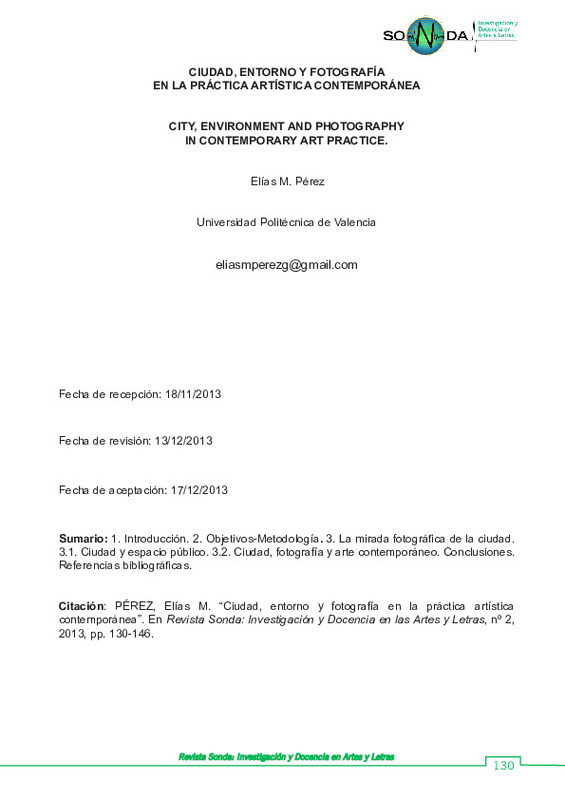|
Resumen:
|
[EN] In a political, economic and social context of crisis, public space has again become a prime location for the collective manifestation of dissent with the power, and the city, scenario of inequality, object and means ...[+]
[EN] In a political, economic and social context of crisis, public space has again become a prime location for the collective manifestation of dissent with the power, and the city, scenario of inequality, object and means for reflection and citizenship claim. Artistic practices interpret, document and / or actively participate in this complex scenario, and photography, almost from its origins in the industrial revolution, has been an appropriate way to interpret the reality of cities immersed in constant changes and confrontations.The use of photography by contemporary art practices as a means to interpret the context, as essential companion to the documentary record of ephemeral or new modes of narrative construction proposals, has facilitated the implementation of the historical demand of the entry of photography in the art institutions. On the other hand, photography has marked the development of the specific history of the medium itself.Along with the incomprehensible and available production, at all times and in all places, and the almost obscene visibility from every corner of the planet and its endless biographies, some artists are still working to uncover new aspects and contradictions in the corners of the contemporary city, participating in the collective definition of the public sphere, from positions that challenge not only the contradictions of context, but also the fundamentals of the medium and, of course, the exhibition and dissemination channels.
[-]
[ES] En un contexto político, económico y social de crisis, el espacio público se ha convertido de nuevo en un lugar privilegiado para la manifestación colectiva de la disensión con el poder, y la ciudad, escenario de la ...[+]
[ES] En un contexto político, económico y social de crisis, el espacio público se ha convertido de nuevo en un lugar privilegiado para la manifestación colectiva de la disensión con el poder, y la ciudad, escenario de la desigualdad, en objeto y medio para la reflexión y la reivindicación ciudadana. Las prácticas artísticas interpretan, documentan y/o participan activamente en este escenario complejo, y la fotografía, prácticamente desde sus orígenes en la revolución industrial, ha sido un medio idóneo para interpretar la realidad de unas ciudades sumidas en el cambio y la confrontación constante.La utilización de la fotografía por las prácticas artísticas contemporáneas como medio para interpretar el contexto, como compañera indispensable para el registro documental de propuestas efímeras o como nuevos modos de construcción narrativa, ha facilitado el cumplimiento de la reivindicación histórica de la entrada de la fotografía en las instituciones artísticas, y por otro lado, ha marcado la evolución de la propia historia específica del medio. Junto a la inabarcable producción y disponibilidad de imágenes en todo momento y en todo lugar, junto a la casi obscena visibilidad de cada rincón del planeta y de sus infinitas biografías, algunos artistas siguen trabajando por desvelar nuevos aspectos y contradicciones en los rincones de la ciudad contemporánea, participando en la definición colectiva de la esfera pública, desde posturas que cuestionan no sólo las contradicciones del contexto, sino también los fundamentos del medio y por supuesto, los canales de exhibición y difusión.
[-]
|








